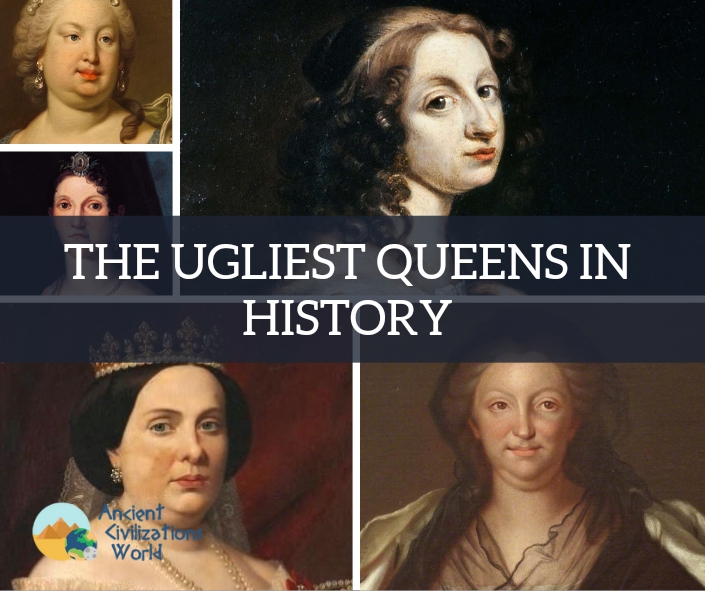Beauty has been a treasured asset for many throughout history, inspiring philosophers, artists, and powerful figures. While beauty is often subjective, it’s generally linked to certain objective parameters like proportion. However, perceptions of beauty vary greatly, and what one person finds beautiful, another may not. This concept applies to people as well, where some historically seductive figures were not conventionally attractive, while others leveraged their looks for gain. Not all queens are remembered for their beauty, but for other traits like intelligence, ambition, and power. This gallery is dedicated to reviewing some of these notable figures.
The 16 ugliest queens in history
Contents
- The 16 ugliest queens in history
- Barbara of Braganza
- Charlotte Joaquina de Bourbon
- Christina of Sweden
- Elizabeth of Farnese
- Elizabeth II of Spain
- Margaret Theresa of Austria
- Maria Amalia of Saxony
- Mary Tudor
- Barbara of Braganza
- Charlotte Joaquina de Bourbon
- Christina of Sweden
- Elizabeth of Farnese
- Elizabeth II of Spain
- Margaret Theresa of Austria
- Maria Amalia of Saxony
- Mary Tudor
Barbara of Braganza
- Role: Consort of King Ferdinand VI (1746-1758)
- Notable Aspects: Suffered from obesity, had strong charisma, and was a lover of fine arts and music.
- Remark: Known for her strong presence, such that the French ambassador compared her favorably to previous monarchs.
Charlotte Joaquina de Bourbon
- Role: Infanta of Spain
- Notable Aspects: Remembered for her ambition and political intrigues.
- Key Events: Asserted her claim to the throne during her brother’s imprisonment and the French occupation of Spain. Later involved in controversies and suspected of regicide.
Christina of Sweden
- Role: Queen of Sweden (1644-1654)
- Notable Aspects: Known for her intellect and creativity rather than physical beauty.
- Contributions: Amassed a significant art collection, founded the Academy of Arcadia, and championed individual liberties.
Elizabeth of Farnese
- Role: Queen Consort of Philip V of Spain (1700-1746)
- Notable Aspects: Ambitious, skilled in selecting capable ministers.
- Impact: Her efforts led to beneficial reforms and improvements in Spain’s economy.
Elizabeth II of Spain
- Role: Queen of Spain (1833-1868)
- Notable Aspects: Faced challenges in meeting progressive demands, leading to political irresponsibility and decline of the monarchy.
- Outcome: Removed from power during the Revolution of 1868.
Margaret Theresa of Austria
- Role: Infanta of Austria
- Notable Aspects: Iconic figure in art history, featured in Velázquez’s “Las Meninas”.
- Life Events: Short and tragic life, marked by arranged marriages and difficult childbirths.
Maria Amalia of Saxony
- Role: Queen Consort of Spain (1759-1760) and of Naples and Sicily (1737-1759)
- Notable Aspects: Married young, had a close relationship with her husband, died of tuberculosis at age 36.
Mary Tudor
- Role: Queen of England (1553-1558)
- Notable Aspects: First queen to rule England in her own right, known for her persecution of Protestants.
- Legacy: Her reign led to many executions for heresy, earning her the nickname ‘Bloody Mary’.
Beauty has been a treasured asset for many throughout history, inspiring philosophers, artists, and powerful figures. While beauty is often subjective, it’s generally linked to certain objective parameters like proportion. However, perceptions of beauty vary greatly, and what one person finds beautiful, another may not. This concept applies to people as well, where some historically seductive figures were not conventionally attractive, while others leveraged their looks for gain. Not all queens are remembered for their beauty, but for other traits like intelligence, ambition, and power. This gallery is dedicated to reviewing some of these notable figures.
Barbara of Braganza
- Role: Consort of King Ferdinand VI (1746-1758)
- Notable Aspects: Suffered from obesity, had strong charisma, and was a lover of fine arts and music.
- Remark: Known for her strong presence, such that the French ambassador compared her favorably to previous monarchs.
Charlotte Joaquina de Bourbon
- Role: Infanta of Spain
- Notable Aspects: Remembered for her ambition and political intrigues.
- Key Events: Asserted her claim to the throne during her brother’s imprisonment and the French occupation of Spain. Later involved in controversies and suspected of regicide.
Christina of Sweden
- Role: Queen of Sweden (1644-1654)
- Notable Aspects: Known for her intellect and creativity rather than physical beauty.
- Contributions: Amassed a significant art collection, founded the Academy of Arcadia, and championed individual liberties.
Elizabeth of Farnese
- Role: Queen Consort of Philip V of Spain (1700-1746)
- Notable Aspects: Ambitious, skilled in selecting capable ministers.
- Impact: Her efforts led to beneficial reforms and improvements in Spain’s economy.
Elizabeth II of Spain
- Role: Queen of Spain (1833-1868)
- Notable Aspects: Faced challenges in meeting progressive demands, leading to political irresponsibility and decline of the monarchy.
- Outcome: Removed from power during the Revolution of 1868.
Margaret Theresa of Austria
- Role: Infanta of Austria
- Notable Aspects: Iconic figure in art history, featured in Velázquez’s “Las Meninas”.
- Life Events: Short and tragic life, marked by arranged marriages and difficult childbirths.
Maria Amalia of Saxony
- Role: Queen Consort of Spain (1759-1760) and of Naples and Sicily (1737-1759)
- Notable Aspects: Married young, had a close relationship with her husband, died of tuberculosis at age 36.
Mary Tudor
- Role: Queen of England (1553-1558)
- Notable Aspects: First queen to rule England in her own right, known for her persecution of Protestants.
- Legacy: Her reign led to many executions for heresy, earning her the nickname ‘Bloody Mary’.

